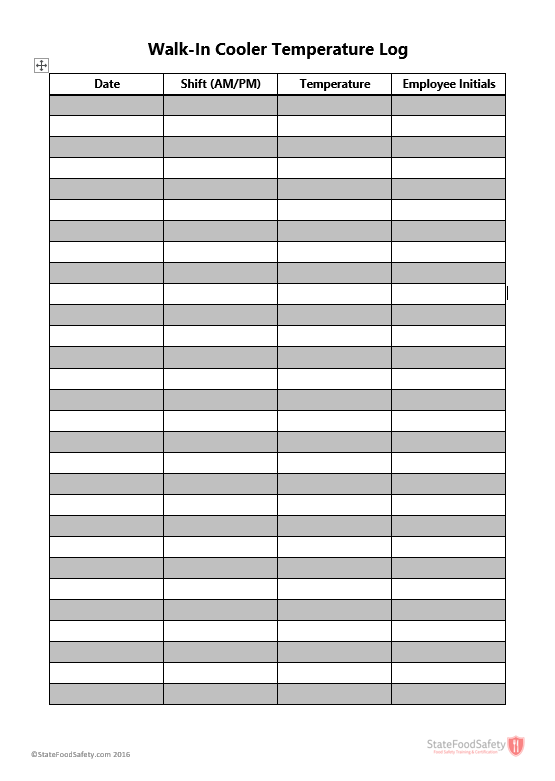A refrigerator temperature log is an essential tool in maintaining food safety and quality in commercial kitchens, restaurants, and other food service establishments. By regularly monitoring and documenting the temperatures in refrigerators and freezers, food businesses can ensure that their perishable items are stored at safe temperatures. In this article, we will discuss the importance of refrigerator temperature logs and provide some templates that can be used for this purpose.
Why is a refrigerator temperature log important?
Maintaining proper refrigeration temperatures is crucial for preventing the growth of bacteria and other pathogens in perishable food items. When the temperature inside a refrigerator rises above the recommended range of 32°F to 40°F (0°C to 4°C), the risk of foodborne illnesses increases significantly. Therefore, regular monitoring of refrigerator temperatures is vital to ensure the safety of the food being stored.
By keeping a temperature log, food businesses can track any deviations from the recommended temperature range and take corrective actions immediately. This helps in identifying and addressing any issues with the refrigeration system, such as malfunctioning thermostats or door seals, before they lead to food spoilage or contamination.
Types of refrigerator temperature logs
There are various types of refrigerator temperature logs available, depending on the specific needs of a food business. Some common types include:
1. Walk-in cooler temperature log:
 This log is specifically designed for walk-in coolers, which are commonly found in large commercial kitchens and food storage facilities. It allows for tracking the temperature in different zones of the walk-in cooler, as well as the time and initials of the person responsible for checking the temperatures.
This log is specifically designed for walk-in coolers, which are commonly found in large commercial kitchens and food storage facilities. It allows for tracking the temperature in different zones of the walk-in cooler, as well as the time and initials of the person responsible for checking the temperatures.
2. Refrigerator temperature log template:
 This template provides a simple format for monitoring the temperature of a standard refrigerator. It includes spaces to record the date, time, temperature, and initials, making it easy to track temperature fluctuations over time.
This template provides a simple format for monitoring the temperature of a standard refrigerator. It includes spaces to record the date, time, temperature, and initials, making it easy to track temperature fluctuations over time.
3. Freezer temperature log:
 This log is specifically designed for freezers and provides spaces to record the temperature in both the refrigerator and freezer compartments. It also includes sections to note any corrective actions taken in case of temperature deviations.
This log is specifically designed for freezers and provides spaces to record the temperature in both the refrigerator and freezer compartments. It also includes sections to note any corrective actions taken in case of temperature deviations.
These are just a few examples of the different types of refrigerator temperature logs that are available. The choice of the log will depend on the specific requirements of the food business and the equipment being used.
How to use a refrigerator temperature log
Using a refrigerator temperature log is simple and straightforward. Here are some general guidelines:
- Print out the temperature log template that is most suitable for your needs.
- Place the log near the refrigerator or freezer, where it can be easily accessed by the staff responsible for monitoring the temperatures.
- Assign a designated person or persons to check the temperature at regular intervals. This could be the kitchen manager, chef, or any staff member who has been trained on food safety practices.
- At each designated time, record the date, time, and temperature in the log. Some logs also have spaces to record the initials of the person performing the check.
- If the temperature falls outside the recommended range, take immediate corrective action. This may involve adjusting the temperature settings, checking the seals on the refrigerator door, or contacting a repair technician if necessary.
- Keep the temperature logs on file for a minimum of one year. These records may be requested during health inspections or audits.
Regularly reviewing the temperature logs and analyzing the data can provide valuable insights into the performance of the refrigeration system. It allows businesses to identify trends, such as recurring temperature fluctuations at specific times of the day, and take proactive measures to prevent food spoilage or contamination.
Conclusion
A refrigerator temperature log is an effective tool for maintaining food safety and quality in commercial kitchens and food service establishments. By regularly monitoring and documenting the temperatures in refrigerators and freezers, businesses can identify and address any issues with the refrigeration system before they result in foodborne illnesses or product losses.
Various templates and logs are available to suit the specific needs of different food businesses. These logs provide a record of temperature fluctuations over time, allowing for the identification of trends and the implementation of corrective actions when necessary.
Remember, maintaining proper refrigeration temperatures is essential for ensuring the safety and quality of perishable food items. By using a refrigerator temperature log, businesses can demonstrate their commitment to food safety and protect the health of their customers.